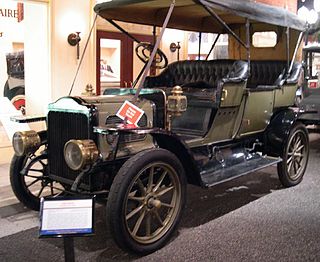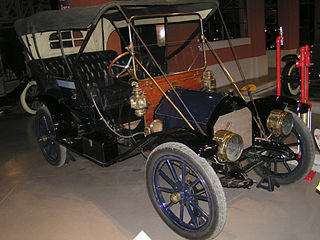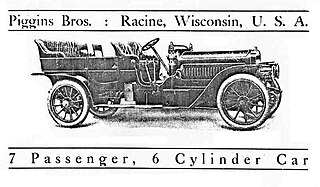
Studebaker was an American wagon and automobile manufacturer based in South Bend, Indiana, with a building at 1600 Broadway, Times Square, Midtown Manhattan, New York City. Founded in 1852 and incorporated in 1868 as the Studebaker Brothers Manufacturing Company, the firm was originally a coachbuilder, manufacturing wagons, buggies, carriages and harnesses.

The E-M-F Company was an early American automobile manufacturer that produced automobiles from 1909 to 1912. The name E-M-F was gleaned from the initials of the three company founders: Barney Everitt, William Metzger, and Walter Flanders.

The Brass Era is an American term for the early period of automotive manufacturing, named for the prominent brass fittings used during this time for such features as lights and radiators. It is generally considered to encompass 1896 through 1915, a time when cars were often referred to as horseless carriages.

L'Aster, Aster, Ateliers de Construction Mecanique l'Aster, was a French manufacturer of automobiles and the leading supplier of engines to other manufacturers from the late 1890s until circa 1910/12. Although primarily known as an engine mass manufacturer the company also produced chassis for coach-works and a complete range of components.

A steam car is a car (automobile) propelled by a steam engine. A steam engine is an external combustion engine (ECE), whereas the gasoline and diesel engines that eventually became standard are internal combustion engines (ICE). ECEs have a lower thermal efficiency, but carbon monoxide production is more readily regulated.
Superior Coach was a coachbuilder in the American automotive industry. Founded in 1909 as the Garford Motor Truck Company, Superior is best known for constructing bodies for professional cars (hearses) and school buses. Following major downturns in both segments in the late 1970s, Superior was liquidated by its parent company in 1980. From 1925 to 1980, the company was based in Lima, Ohio.

Baker Motor Vehicle Company was an American manufacturer of Brass Era electric automobiles in Cleveland, Ohio, from 1899 to 1914.

Woods Motor Vehicle Company was an American manufacturer of electric automobiles in Chicago, Illinois, between 1899 and 1916. In 1915 they produced the Dual Power with both electric and internal combustion engines which continued until 1918.

Development of the automobile started in 1672 with the invention of the first steam-powered vehicle, which led to the creation of the first steam-powered automobile capable of human transportation, built by Nicolas-Joseph Cugnot in 1769. Inventors began to branch out at the start of the 19th century, creating the de Rivaz engine, one of the first internal combustion engines, and an early electric motor. Samuel Brown later tested the first industrially applied internal combustion engine in 1826.

Columbia was an American brand of automobiles produced by a group of companies in the United States. They included the Pope Manufacturing Company of Hartford, Connecticut, the Electric Vehicle Company, and an entity of brief existence in 1899, the Columbia Automobile Company.

Studebaker-Garford was an automobile produced and distributed jointly by the Garford Company of Elyria, Ohio, and the Studebaker Corporation of South Bend, Indiana, from 1904 through 1911. During its production, the car was sold as a Studebaker, per the marketing agreement between the two firms, but Studebaker collectors break the vehicles out under the Studebaker-Garford name because of the extent of Garford components.

The Everitt was an American automobile manufactured from 1909 until 1912 by the Metzger Motor Car Company in Detroit.

The Piggins was a brass era American luxury automobile manufactured in 1908 and 1909 in Racine, Wisconsin by the Piggins Brothers.

John Mohler Studebaker was the Pennsylvania Dutch co-founder and later executive of what would become the Studebaker Corporation automobile company. He was the third son of the founding Studebaker family, and played a key role in the growth of the company during his years as president, from 1868 until his death in 1917.

The Union automobile was a vehicle manufactured by the Union Automobile Company from 1902 until 1905. It was designed by John William Lambert, who had developed the three-wheel Buckeye gasoline buggy in 1891. Over the next decade, Lambert substantially refined the vehicle, with modifications including an additional wheel, a more powerful engine, and a new transmission system. The Union Automobile Company was formed as a subsidiary of Lambert's Buckeye Manufacturing Company solely to manufacture the Union, which took its name from Union City, Indiana, the city where it was built and which endorsed its production. In total, the company built over three hundred Union automobiles, before development shifted to the Lambert automobile, the Union's successor.
Frederick Samuel "Fred" Fish, born in Newark, was an American lawyer, politician and automotive manufacturing executive. Originally a successful corporation lawyer, he entered the Studebaker corporation through marriage and became the corporation's president in 1909 and chairman of the board from 1915 to 1935. He is credited with introducing the manufacture of Studebaker cars, first electric, then gasoline-powered.

Oliver Parker Fritchle was an American chemist, storage battery innovator, and entrepreneur with electric vehicle and wind power generation businesses during the early twentieth century. His initial battery patent was awarded in 1903 and by 1904 he had established what was to become the Fritchle Automobile & Battery Company in Denver, Colorado. He was an early adaptor and developer of significant automotive technologies, such as regenerative braking and hybrid drivetrains, that did not reemerge on production vehicles of major car companies until late in the twentieth century.

Rainier Motor Car Company was an American automobile manufacturer founded in 1905 by John T. Rainier in Flushing, New York and from 1908 produced in Saginaw, Michigan. The company specialized in manufacturing large and luxurious automobiles. In 1909, the company was bought by General Motors who maintained the brand until 1911.
Brennan Motor Manufacturing Company (1897–1972) of Syracuse, New York, was an early manufacturer of automobile engines. From 1902 until 1908, the company produced the Brennan automobile however, after the demise of the automobile enterprise, the company again turned their focus to automobile engines and later marine engines. They were in business for 75 years when the company closed its doors in 1972.















